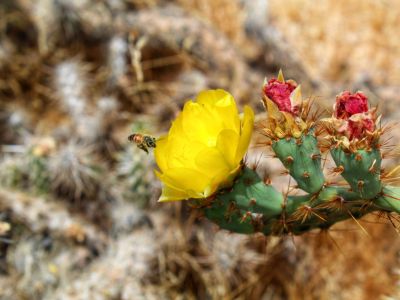The world is facing a honey bee crisis. Bees are one of the top pollinators, but by no means the only ones. Moths, wasps, birds, and even bats are also part of the pollinating chain. Building a pollinator garden in the southwest can encourage these important creatures to make their home in your landscape.
Native Southwest Plants for Pollinators
Native plants can be just as beautiful as imported and cultivated varieties. They are also hardy to the region and adaptable to its climate. The southwest region is characterized by hot, dry weather, often accompanied by drying winds. There is generally little rainfall, especially during summer. These conditions offer a challenge to the gardener. Selecting plants that naturally thrive in the area helps offset the tests posed by such conditions. Wildflowers afford an excellent opportunity to beautify the landscape while producing a desert pollinator garden. Southwest plants for bees and other pollinators might be:
RedbudMesquitePrairie AcaciaPalo VerdeDesert IronwoodFairy DustersDessert SennaSacred Thorn AppleCommon SotolLupineVelvetpod MimosaQueen’s Wreath VineFragrant BeebrushParry’s BeardtongueYucca
Southwest Plants for Bees
Plants that are hardy to United States Department of Agriculture zones 8a-10a and bloom prolifically are great southwest plants for bees. Bees are proficient at getting nectar from a variety of flower shapes. Shallow dish, funnel or tubular, and rayed blooms are all excellent platforms for bee feeding. Bees seem most attracted to blooms in hues of blue, white, and yellow, but will also visit other colors. Herbs of all types are excellent southwest plants for pollinators such as bees. A diverse mixture of annuals and perennials will attract bees and other pollinating insects. The southwest pollinator garden should have flowers present from early spring, well into fall, to provide sustenance for these hard working creatures.
Tips on a Pollinator Garden in the Southwest
Pollinators need more than food to keep them in your garden. They also need shelter and water, as well as protection from the use of insecticides. Even herbicides can kill off important sources of food and host plants necessary for larval development. Minimize the amount of digging that occurs to protect insect colonies and larvae that live in the soil. Interspersing vegetative plants with flowering species will allow resting points, wind breaks, and shelter as the insects do their work. Consider using a pond, fountain, or just empty container to provide adequate water. Just a little care and planning can increase the pollinating species in your landscape and ensure the health of your plants.
